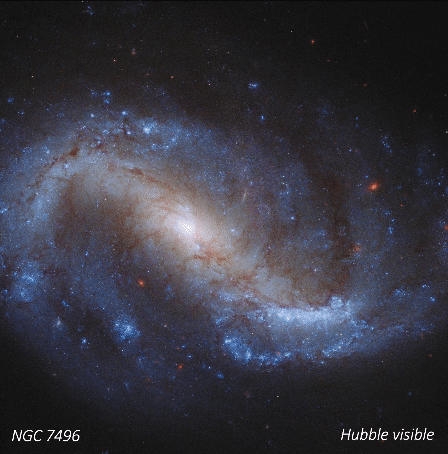James Webb Space Telescope Discovery
Clicking on each image will open the full resolution one. Try it!Clicking on "Raw images" image will yield all the relevant raw images.
PHANGS: Webb vs Hubble
The PHANGS program is building the first dataset to enable the multi-phase, multi-scale study of star formation across nearby spiral galaxies. The foundation of PHANGS has been built with large surveys with Hubble, JWST, ALMA and VLT/MUSE.
Credit: MAST.
 This animated image shows NGC 7496 as viewed by Hubble in visible light and JWST in infrared light
This animated image shows NGC 7496 as viewed by Hubble in visible light and JWST in infrared light
Face-on spiral galaxy is split diagonally in this image: Webb’s observations appear at top left, and the Hubble’s at bottom right. Webb and Hubble’s images show a striking contrast, an inverse of darkness and light. Why? Webb’s observations combine near- and mid-infrared light and Hubble’s showcase visible and ultraviolet light. Dust absorbs ultraviolet and visible light, and then re-emits it in the infrared. In Webb's images, we see dust glowing in infrared light. In Hubble’s images, dark regions are where starlight is absorbed by dust.
Gas and Dust
In Webb’s high-resolution infrared images, the gas and dust stand out in stark shades of orange and red, and show finer spiral shapes with the appearance of jagged edges, though these areas are still diffuse.
In Hubble’s images, the gas and dust show up as hazy dark brown lanes, following the same spiral shapes. Its images are about the same resolution as Webb’s, but the gas and dust obscure a lot of the smaller-scale star formation.
Bright Central Spikes
Bright red diffraction spikes at a galaxy’s core in a Webb image can be a “calling card” of an active supermassive black hole, as seen in NGC 7496. Not all oversized diffraction spikes at galaxies’ cores are caused by black holes, though. Sometimes, they appear when a slew of very bright, centrally located star clusters are in the central region of Webb’s image.
In Hubble’s images, the galaxies’ cores are not as bright so these spikes are absent. Diffraction spikes only appear when the source is extremely bright and compact.
Older Stars
Sometimes, the central region in Webb’s image has a blue glow. This is a marker of high concentrations of older stars. Webb’s infrared observations allow us to see through the gas and dust to identify these older stars. The light these old stars emit are some of the shortest infrared wavelengths in Webb’s images, which is why they are assigned blue.
In comparison, the cores of Hubble’s image may appear yellower, washing the central region in a soft glow and fully obscuring individual points of light. Hazy brown dust lanes may also cover part of this area. In Hubble’s images, older stars are emitting some of the longest wavelengths of visible light Hubble captures, which is why the color assignments are different.
Younger Stars
In Webb’s image, the newly fully formed stars also appear blue along the galaxies’ spiral arms. Those blue stars have blown away the gas and dust that immediately surrounded them. The farther away they are from the core, the more likely stars are to be younger. Orange stars, likely seen in groups in these images, are even younger: They are still encased in their cocoons of gas and dust, allowing them to continue forming.
In Hubble’s images, younger stars pop out in blue and purple – and appear almost everywhere. In contrast, the older stars near the center of the galaxy appear yellowish.
Star-Forming Regions
Look for knots of bright red and orange in Webb’s image. These are especially easy to identify toward the outer edges of the galaxy’s spiral arms. These are regions of star formation, and mid-infrared light highlights the gas and dust that are a huge part of the mix, since they are primary ingredients for stars that are actively forming.
In Hubble’s images, star-forming regions are clusters of bright blue and purple, or sometimes red and pink as hot stars energize nearby hydrogen gas.
Credit: NASA, ESA, CSA, STScI, Janice Lee (STScI), Thomas Williams (Oxford), Rupali Chandar (UToledo), PHANGS Team.
 IC 5332
IC 5332
 NGC 1087
NGC 1087
 NGC 1300
NGC 1300
 NGC 1365
NGC 1365
 NGC 1385
NGC 1385
 NGC 1433
NGC 1433
 NGC 1512
NGC 1512
 NGC 1566
NGC 1566
 NGC 1672
NGC 1672
 NGC 2835
NGC 2835
 NGC 3351
NGC 3351
 NGC 3627
NGC 3627
 NGC 4254
NGC 4254
 NGC 4303
NGC 4303
 NGC 4321
NGC 4321
 NGC 4535
NGC 4535
 NGC 5068
NGC 5068
 NGC 628
NGC 628
 NGC 7496
NGC 7496
 PHANGS image mosaic discovery page
PHANGS image mosaic discovery page